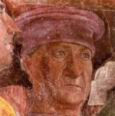(Italy 1431-1506)
Italian painter born in Isola di Sopra, a town located in the territory of Vicenza, in 1431. The documents published by Víctor Lazzarini put an end to the discussions that pointed to Vicenza or Padua as the presumed birthplaces of the great humanistic painter.
Orphaned from a very young age, Mantegna was adopted by the painter Francesco Squarcione, who made him join the Fraglia or guild of painters in Padua. Squarcione, who was considered until very recently a mere local master, was actually the head of an artistic faction, whose teachings were followed by many artists from different cities in Northern Italy, reaching a total of 137 disciples. However, the relationship between the precocious artist and his adoptive father was not as cordial as one might deduce from the adoption and teaching agreement, as Mantegna appeared before the Paduan magistrates on January 28, 1448, requesting a separation from his supposed protector, which he obtained. The young painter's fame was already so great that he was only eighteen years old when Lionello de Este called him to portray him alongside Folco de Villafora.
In 1453, Mantegna married Nicolasa Bellini, daughter of Jacobo and sister of Gentil and Giovanni Bellini, a union that, considering the rank of the Bellini family, demonstrates the cordiality and longevity of Mantegna's relations with the family of the great Venetian painters.
In 1459 he moved to Padua, where he worked for some time for the podestà Antonio Marcello, moving as soon as he could to Mantua, where he was urgently called by Marquis Ludovico Gonzaga to complete the chapel of the palace, which had been started following the painter's indications. These works and those requested by other powerful patrons indicate that the name of Mantegna enjoyed enviable and deserved fame in 1460.
The last works of Mantegna were executed for the gallery of Isabella d'Este. In 1476, Mantegna built a studio and a house that he never inhabited, with the courtyard still preserved. The building, called the Olympus, corresponded to the classical tastes of the painter. Mantegna died on September 13, 1506, with his children being forced to sell some works to Cardinal Gonzaga both to complete the chapel dedicated to the great painter in the church of San Andrea in Mantua and to settle some debts.
Among his works stand out Arrival of the Cardinal, Christ Descending into Limbo, Dead Christ, Saint Sebastian, Assumption of the Virgin...
Italian painter born in Isola di Sopra, a town located in the territory of Vicenza, in 1431. The documents published by Víctor Lazzarini put an end to the discussions that pointed to Vicenza or Padua as the presumed birthplaces of the great humanistic painter.
Orphaned from a very young age, Mantegna was adopted by the painter Francesco Squarcione, who made him join the Fraglia or guild of painters in Padua. Squarcione, who was considered until very recently a mere local master, was actually the head of an artistic faction, whose teachings were followed by many artists from different cities in Northern Italy, reaching a total of 137 disciples. However, the relationship between the precocious artist and his adoptive father was not as cordial as one might deduce from the adoption and teaching agreement, as Mantegna appeared before the Paduan magistrates on January 28, 1448, requesting a separation from his supposed protector, which he obtained. The young painter's fame was already so great that he was only eighteen years old when Lionello de Este called him to portray him alongside Folco de Villafora.
In 1453, Mantegna married Nicolasa Bellini, daughter of Jacobo and sister of Gentil and Giovanni Bellini, a union that, considering the rank of the Bellini family, demonstrates the cordiality and longevity of Mantegna's relations with the family of the great Venetian painters.
In 1459 he moved to Padua, where he worked for some time for the podestà Antonio Marcello, moving as soon as he could to Mantua, where he was urgently called by Marquis Ludovico Gonzaga to complete the chapel of the palace, which had been started following the painter's indications. These works and those requested by other powerful patrons indicate that the name of Mantegna enjoyed enviable and deserved fame in 1460.
The last works of Mantegna were executed for the gallery of Isabella d'Este. In 1476, Mantegna built a studio and a house that he never inhabited, with the courtyard still preserved. The building, called the Olympus, corresponded to the classical tastes of the painter. Mantegna died on September 13, 1506, with his children being forced to sell some works to Cardinal Gonzaga both to complete the chapel dedicated to the great painter in the church of San Andrea in Mantua and to settle some debts.
Among his works stand out Arrival of the Cardinal, Christ Descending into Limbo, Dead Christ, Saint Sebastian, Assumption of the Virgin...


